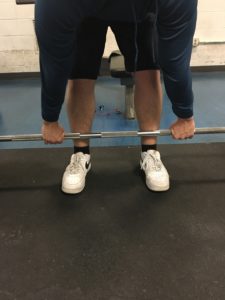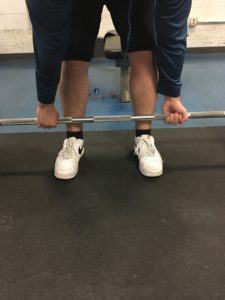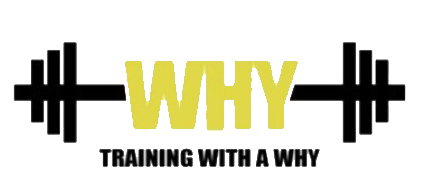First, Respect It
It’s hard to describe, the feeling that runs through my body when I hear someone describe an exercise as dangerous. The weight room is not unlike many situations in life. If you do something carelessly or incorrectly the chances of you becoming injured increase substantially. However, if you use common sense, remain focused, and are aware of certain things, those chances of becoming injured decrease by a large margin. There are no dangerous exercises. Sure, there are exercises that come with more risk if done improperly compared to other exercises, but I don’t believe they should be tagged with the word dangerous. The deadlift is usually the exercise most commonly associated with this “dangerous” stereotype. The squat is a close second but that will come in a later article. Yes, if you deadlift improperly and without care you are probably going to injure yourself, most likely not seriously, but enough to make you think it’s the exercise that is the problem and not you. Well friend, I’m here to tell you it’s not the exercise, it’s you. It’s you and the person trying to teach you the exercise that watched a few deadlift videos on YouTube that is the problem. Lifting heavy weight off the ground is no joke, it’s a grown man, or grown woman, lift. It needs to be respected. I can’t tell you how many times I’ve been in a local gym and have seen someone attempting to do a set of deadlifts. They are texting on their phone, walk up to the bar, joking around with their buddies, talking to them, sometimes even laughing all the while grabbing the bar to pick it up, they complete a few painful looking reps, set it back down and walk away saying their back hurts. Respect the deadlift enough to learn how to do it properly and the “dangerous” stereotype will soon be a thing of the past. Here is how to perform a correct conventional deadlift.
The Setup
- With the bar on the ground, walk up to it leaving an inch or two between your shins and the bar.
- Your feet should be in your power stance. (See notes section below)
- “Hinge” down o the bar by shifting your weight on to your heels and pushing your butt back until your shins make contact with the bar. (See notes section for comments on knee placement.)
- Maintain a flat back and a “big” chest. (Create a “big” chest by puffing your chest out. Picture the guys that want to act tough walking through high school hallways.)
- Grab the bar about an inch outside of your shins. You don’t want your thumbs touching your shins.
- Your eyes should be about 6-8 feet in front of you on the ground and remain there the entire time. This keeps your chin and thus your head in a neutral position.
Tips:
- Your power stance is where you feel you can create the most power from. A good way to find this is to take one step and act like you are going to do a vertical jump. After bringing the second foot forward, as in a jumping movement, look down at your feet and this is going to be your power stance.
- By “hinging” down to the bar your knees should be “soft” or slightly bent. Definitely not in a locked put position and not as bent as in a squat.
- I highly advise using the double overhand position when first learning how to deadlift. When you become sufficient with the technique go ahead and try the over-under grip which allows you to lift more weight.

The double overhand Grip

The over-under Grip
Breaking the Bar
When you are in the correct position the last thing I advise you to do is to take a deep breath in at the same time you “break” the bar. Breaking the bar reinforces that your back is engaged, especially your lats, and that your grip is as strong as possible. It also takes the remaining slack out of the bar. Taking the slack out of the bar is important because like our own bodies, the more slack that is involved in the lift the more energy we need to move it. So before moving the weight we want our own body and also the bar to be as tight as possible.
- When attempting to “break” the bar, think about bending the bar around your shins.
- It may also help to think about holding a stick out in front of you and snapping it in half. (Be sure to watch video below)
- You should instantly feel your lats engage and your lifting buddy should visibly see your lats and upper back tighten.
- Depending on the type of bar you are using, you may be able to hear and definitely feel the slack leave the bar. It will most likely make a clicking sound when the slack leaves.
Video Here: Breaking The Bar
Stand Up and Lockout
- When pulling the weight off the ground be careful not pull or jerk the weight up using your arms.
- Think of your arms as just ropes holding the bar as you stand upright.
- Instead of jerking the weight up with your arms think about standing up by driving with your legs.
- You should feel leg drive, which simply means you feel as though you are pressing the floor with your feet.
- Be sure to keep the bar tight to your shins and thighs as you stand up.
- You should be standing completely upright in the lockout position.
- Your glutes should be tight and your hips “driven” forward.
- Be sure not to arch your lower back. Your hips are driven forward but everything from the waist up is in a neutral upright position.
Tips:
- When returning the bar to the ground simply reverse the process by shifting your weight onto your heels and pushing your butt back.
- Be sure to maintain the structured back and big chest on the way down.
- Keep the bar tight to your legs on the way down as well.
- Your eyes should remain in the same spot on the way down.

Reap the Benefits
There is a definite separation in the gym between those people that deadlift properly and those that do it wrong or not at all. Like I said, it is a grown man or grown woman lift. It isn’t easy by any means but it is worth learning. Once you become stronger in the deadlift you will notice that you feel stronger overall and a good chance even more athletic. Also, you will actually experience less low back pain throughout your daily life because of the improved strength. So, learn it, perfect it, and reap the benefits of the deadlift.
As always, thanks for reading and please let me know if you liked this type of instructional article and be sure to subscribe to the site to stay up to date on future articles.
Check out the video below that puts everything together.
Video Here: Deadlift


